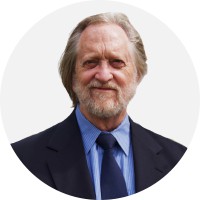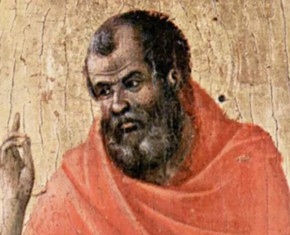The views expressed in our content reflect individual perspectives and do not represent the authoritative views of the Baha'i Faith.
Let’s examine a few very useful symbolic and metaphorical expressions of the intermediary relationship between God and humankind, between the Creator and His messengers.
These metaphors can each provide us with significant insight and logical elucidation about the divinely ordained process of progressive revelation portrayed in the Baha’i teachings, because, as Abdu’l-Baha said:
Religion is the outer expression of the divine reality. Therefore, it must be living, vitalized, moving and progressive. If it be without motion and nonprogressive, it is without the divine life; it is dead. The divine institutes are continuously active and evolutionary; therefore, the revelation of them must be progressive and continuous.
RELATED: “Ye Shall Know Them By Their Fruits:” 4 Ways to Assess a Prophet
The Prism
Examining the nature of a prism can be an extremely useful analogy for explaining how the prophets, messengers, and manifestations function as intermediaries between the Holy Spirit — the attributes and powers emanating from God — and humanity as the recipients of this bounty. Of particular value is the capacity of the prism to demonstrate how the manifestation is capable of making that which is unseen or invisible to the naked eye – the metaphysical nature and powers of the Holy Spirit – become visible, accessible, and varied.
By refracting the array of light lengths into a rainbow of colors latent in the pure white light of the sun, the prism becomes an intermediary, whereby we glimpse the complexity of what is otherwise beyond our immediate comprehension. Of course, through more sophisticated instruments, such as a spectrometer, we can begin to realize that there is much we still do not understand, that there is literally an infinite array of attributes that are beyond our common perception.
By analogy, the divine manifestations likewise have the capacity to demonstrate to us in sensually and intellectually comprehensible terms the attributes of the Holy Spirit emanating from God. All of the manifestation’s words and actions translate for us this otherwise imperceptible spiritual force into advice, laws, exhortations, and visual examples of all we are able to comprehend and apply in our daily lives.
The prism analogy illustrates well that while the ultimate source of all power is God, the manifestation functions as the primary means by which the nature and power of God is made apparent to us, that we might comprehend and then emulate these otherwise concealed attributes.
Naturally, we will never understand God directly, not even in the continuation of our lives beyond our physical experience. But it would seem totally erroneous to conclude that we cannot know God. We are given the opportunity through the appearance and guidance of the prophets to comprehend all the attributes or nature of God.
What we can never comprehend is the essence of God, His essential reality. The essential reality of God is beyond the comprehension of any being but Himself. It is in this literal sense that we say God is “essentially unknowable.”
The Mirror
Another useful analogy for understanding the function and the unity of the messengers and manifestations is the relationship between sunlight and a mirror.
If we think of each of the manifestations as a distinctly perfect reflection of sunlight, we can appreciate that each is capable of conveying to us flawlessly all the visual attributes of the sun. Consequently, the sun need not descend to Earth, nor even shine upon the Earth directly, for us to receive its bounties. Were there perfect mirrors in space capable of reflecting that light to us, we would not be able to distinguish between the two sources, the sun or the mirror, nor would we need to.
Each manifestation thus reflects the same light from the same source. Yet because each manifestation of God – such as Buddha, Moses, Christ, Muhammad and most recently Baha’u’llah – appears at a distinct time in a distinct persona, we understandably view them as distinct sources of guidance. In reality, the light they bring is the same light from the same source, in the same way that we give different names to different days of the week even though on each new day the same sun dawns with the same rays and attributes. In his Book of Certitude, Baha’u’llah wrote:
These Tabernacles of holiness, these primal Mirrors which reflect the light of unfading glory, are but expressions of Him Who is the Invisible of the Invisibles. By the revelation of these gems of divine virtue all the names and attributes of God, such as knowledge and power, sovereignty and dominion, mercy and wisdom, glory, bounty and grace, are made manifest.
From this analogy we can also appreciate the Baha’i axiom that each of these sequential “mirrors” are equally capable of reflecting all of the Creator’s divine attributes with whatever intensity they wish. That each prophet and messenger “illumines” humanity only to the extent that we are capable of receiving that light at a given historical context can be attributed to their infinite wisdom as divine educators – they reveal only so much light as we are able to find useful at a given stage in our continuous social and spiritual advancement.
In this sense, whatever portion we receive is purely and flawlessly conveyed, though we will never receive all of the enlightenment available. Were this to occur, or were we to receive more light than would be tolerable, we would become blinded. Instead of being assisted and educated, we would become totally confused and dumbfounded. Baha’u’llah explained:
Know of a certainty that in every Dispensation the light of Divine Revelation hath been vouchsafed unto men in direct proportion to their spiritual capacity. Consider the sun. How feeble its rays the moment it appeareth above the horizon. How gradually its warmth and potency increase as it approacheth its zenith, enabling meanwhile all created things to adapt themselves to the growing intensity of its light. How steadily it declineth until it reacheth its setting point. Were it, all of a sudden, to manifest the energies latent within it, it would, no doubt, cause injury to all created things…. In like manner, if the Sun of Truth were suddenly to reveal, at the earliest stages of its manifestation, the full measure of the potencies which the providence of the Almighty hath bestowed upon it, the earth of human understanding would waste away and be consumed; for men’s hearts would neither sustain the intensity of its revelation, nor be able to mirror forth the radiance of its light. Dismayed and overpowered, they would cease to exist.
The Sun, The Light, and the Mirror
Because these prophets and manifestations are perfect mirrors, the attributes of God are manifest in them as completely and flawlessly as if they were God incarnate – and yet each is careful to inform us he is not God. By analogy, we can imagine how easy it would be for the untrained eye to conclude that the prism itself is the source of the wondrous array of colors and powers, not the invisible sunlight shining through it. The same problem holds true for the mirror analogy. If the light shining from the sun is completely and immaculately reflected in a perfectly-polished mirror, we can appreciate why the followers might be tempted to deify the mirror itself – the manifestation – or conclude that the light they see there is God incarnate.
It is precisely for this reason that the prophets and manifestations emphasize time and again to their followers that while they constitute the channel through which the believer can gain access to God, they are distinct from the essence of Creator. They are his dutiful servants, and by no means His peer or co-partner.
RELATED: How Can I Find the Kingdom of Heaven on Earth?
For example, in John 14:31-15:1, Christ compared himself to a vine, and God to the one who cultivates the vine:
But that the world may know that I love the Father; and as the Father gave me commandment, even so I do. Arise, let us go hence. I am the true vine, and my Father is the husbandman.
Likewise, in the Qur’an we find Muhammad asserting that he cannot alter anything in the Qur’an because it emanates not from him but from God:
But when Our Clear Signs are rehearsed unto them, those who rest not their hope on their meeting with Us, say: “Bring us a Reading other than this, or change this.” Say: “It is not for me, of my own accord, to change it: I follow naught but what is revealed unto me: if I were to disobey my Lord, I should myself fear the Penalty of a Great Day (to come).”
Baha’u’llah likewise wrote in his letter to Nasirid-Dín Shah, the king of Persia:
This thing is not from Me, but from One Who is Almighty and All-Knowing. … This is but a leaf which the winds of the will of thy Lord, the Almighty, the All-Praised, have stirred.”
Even so, Baha’u’llah made two statements which reaffirm that for human beings, spiritual proximity to the manifestation is tantamount to entering the presence of God.
First, Baha’u’llah observed that the inherent purpose for which God has created humankind is that we may come to know and worship God and benefit therefrom: “The purpose of God in creating man hath been, and will ever be, to enable him to know his Creator and to attain His Presence.”
In another passage, Baha’u’llah noted that attaining the spiritual presence of the manifestations by recognizing them and obeying their guidance is equivalent to attaining the presence of God:
Therefore, whosoever, and in whatever Dispensation, hath recognized and attained unto the presence of these glorious, these resplendent and most excellent Luminaries, hath verily attained unto the “Presence of God” Himself, and entered the city of eternal and immortal life.
















Comments
Sign in or create an account
Continue with Googleor